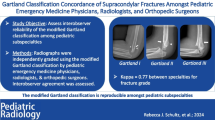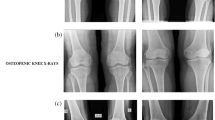Abstract
Objectives
To identify the feasibility of deep learning–based diagnostic models for detecting and assessing lower-extremity fatigue fracture severity on plain radiographs.
Methods
This retrospective study enrolled 1151 X-ray images (tibiofibula/foot: 682/469) of fatigue fractures and 2842 X-ray images (tibiofibula/foot: 2000/842) without abnormal presentations from two clinical centers. After labeling the lesions, images in a center (tibiofibula/foot: 2539/1180) were allocated at 7:1:2 for model construction, and the remaining images from another center (tibiofibula/foot: 143/131) for external validation. A ResNet-50 and a triplet branch network were adopted to construct diagnostic models for detecting and grading. The performances of detection models were evaluated with sensitivity, specificity, and area under the receiver operating characteristic curve (AUC), while grading models were evaluated with accuracy by confusion matrix. Visual estimations by radiologists were performed for comparisons with models.
Results
For the detection model on tibiofibula, a sensitivity of 95.4%/85.5%, a specificity of 80.1%/77.0%, and an AUC of 0.965/0.877 were achieved in the internal testing/external validation set. The detection model on foot reached a sensitivity of 96.4%/90.8%, a specificity of 76.0%/66.7%, and an AUC of 0.947/0.911. The detection models showed superior performance to the junior radiologist, comparable to the intermediate or senior radiologist. The overall accuracy of the diagnostic model was 78.5%/62.9% for tibiofibula and 74.7%/61.1% for foot in the internal testing/external validation set.
Conclusions
The deep learning–based models could be applied to the radiological diagnosis of plain radiographs for assisting in the detection and grading of fatigue fractures on tibiofibula and foot.
Key Points
• Fatigue fractures on radiographs are relatively difficult to detect, and apt to be misdiagnosed.
• Detection and grading models based on deep learning were constructed on a large cohort of radiographs with lower-extremity fatigue fractures.
• The detection model with high sensitivity would help to reduce the misdiagnosis of lower-extremity fatigue fractures.





Similar content being viewed by others
Abbreviations
- AI:
-
Artificial intelligence
- AUC:
-
Area under the receiver operating characteristic curve
- CI:
-
Confidence interval
- CNN:
-
Convolutional neural network
- NPV:
-
Negative predictive value
- PPV:
-
Positive predictive value
- ROC:
-
Receiver operating characteristic
- TBN:
-
Triplet branch network
References
Anderson MW, Greenspan A (1996) Stress fractures. Radiology 199:1–12
Warden SJ, Burr DB, Brukner PD (2006) Stress fractures: pathophysiology, epidemiology, and risk factors. Curr Osteoporos Rep 4:103–109
Pathria MN, Chung CB, Resnick DL (2016) Acute and stress-related injuries of bone and cartilage: pertinent anatomy, basic biomechanics, and imaging perspective. Radiology 280:21–38
Wilson ES, Katz FN (1969) Stress fractures. An analysis of 250 consecutive cases. Radiology 92:481–486
Pegrum J, Crisp T, Padhiar N (2012) Diagnosis and management of bone stress injuries of the lower limb in athletes. BMJ 344:e2511
Berger FH, de Jonge MC, Maas M (2007) Stress fractures in the lower extremity. The importance of increasing awareness amongst radiologists. Eur J Radiol 62:16–26
Marshall RA, Mandell JC, Weaver MJ et al (2018) Imaging features and management of stress, atypical, and pathologic fractures. Radiographics 38:2173–2192
Raasch WG, Hergan DJ (2006) Treatment of stress fractures: the fundamentals. Clin Sports Med 25:29–36
Matcuk GR, Mahanty SR, Skalski MR et al (2016) Stress fractures: pathophysiology, clinical presentation, imaging features, and treatment options. Emerg Radiol 23:365–375
Muthukumar T, Butt SH, Cassar-Pullicino VN (2005) Stress fractures and related disorders in foot and ankle: plain films, scintigraphy, CT, and MR imaging. Semin Musculoskelet Radiol 9:210–226
Topol EJ (2019) High-performance medicine: the convergence of human and artificial intelligence. Nat Med 25:44–56
Hosny A, Parmar C, Quackenbush J et al (2018) Artificial intelligence in radiology. Nat Rev Cancer 18:500–510
Hendrix N, Scholten E, Vernhout B et al (2021) Development and validation of a convolutional neural network for automated detection of scaphoid fractures on conventional radiographs. Radiol Artif Intell 3:e200260
Lindsey R, Daluiski A, Chopra S et al (2018) Deep neural network improves fracture detection by clinicians. Proc Natl Acad Sci U S A 115:11591–11596
Lee C, Jang J, Lee S et al (2020) Classification of femur fracture in pelvic X-ray images using meta-learned deep neural network. Sci Rep 10:13694
Guan B, Yao J, Wang S et al (2022) Automatic detection and localization of thighbone fractures in X-ray based on improved deep learning method. Comput Vis Image Underst 216:103345
Yu JS, Yu SM, Erdal BS et al (2020) Detection and localisation of hip fractures on anteroposterior radiographs with artificial intelligence: proof of concept. Clin Radiol 75:237.e1–237.e9
Tanzi L, Vezzetti E, Moreno R et al (2020) Hierarchical fracture classification of proximal femur X-ray images using a multistage deep learning approach. Eur J Radiol 133:109373
Hardalaç F, Uysal F, Peker O et al (2022) Fracture detection in wrist X-ray images using deep learning-based object detection models. Sensors (Basel) 22:1285
Choi JW, Cho YJ, Lee S et al (2020) Using a dual-input convolutional neural network for automated detection of pediatric supracondylar fracture on conventional radiography. Invest Radiol 55:101–110
Mutasa S, Varada S, Goel A et al (2020) Advanced deep learning techniques applied to automated femoral neck fracture detection and classification. J Digit Imaging 33:1209–1217
Chung SW, Han SS, Lee JW et al (2018) Automated detection and classification of the proximal humerus fracture by using deep learning algorithm. Acta Orthop 89:468–473
Kaeding CC, Miller T (2013) The comprehensive description of stress fractures: a new classification system. J Bone Joint Surg Am 95:1214–1220
Mulligan ME (1995) The “gray cortex”: an early sign of stress fracture. Skeletal Radiol 24:201–203
Png MA, Koh JSB, Goh SK et al (2012) Bisphosphonate-related femoral periosteal stress reactions: scoring system based on radiographic and MRI findings. AJR Am J Roentgenol 198:869–877
Schilcher J, Bernhardsson M, Aspenberg P (2019) Chronic anterior tibial stress fractures in athletes: no crack but intense remodeling. Scand J Med Sci Sport 29:1521–1528
Fredericson M, Jennings F, Beaulieu C, Matheson GO (2006) Stress fractures in athletes. Top Magn Reson Imaging 17:309–325
He K, Zhang X, Ren S, Sun J (2016) Deep residual learning for image recognition. In: 2016 IEEE Conference on Computer Vision and Pattern Recognition (CVPR). IEEE, pp 770–778
Li Y, Wang Y, Lin G, et al (2021) Triplet-branch network with prior-knowledge embedding for fatigue fracture grading. In: Medical Image Computing and Computer Assisted Intervention-MICCAI 2021. pp 449–458
Zhou B, Cui Q, Wei X-S, Chen Z-M (2020) BBN: bilateral-branch network with cumulative learning for long-tailed visual recognition. In: 2020 IEEE/CVF Conference on Computer Vision and Pattern Recognition (CVPR). IEEE, pp 9716–9725
Cao Z, Qin T, Liu T-Y, et al (2007) Learning to rank. In: Proceedings of the 24th international conference on Machine learning - ICML ’07. ACM Press, New York, New York, USA, pp 129–136
Fu R, Hu Q, Dong X, et al (2020) Axiom-based Grad-CAM: towards accurate visualization and explanation of CNNs. arXiv e-prints arXiv:2008.02312 https://doi.org/10.48550/arXiv.2008.02312
Tang A, Tam R, Cadrin-Chênevert A et al (2018) Canadian Association of Radiologists white paper on artificial intelligence in radiology. Can Assoc Radiol J 69:120–135
Mandell JC, Khurana B, Smith SE (2017) Stress fractures of the foot and ankle, part 1: biomechanics of bone and principles of imaging and treatment. Skeletal Radiol 46:1021–1029
Lefere M, Demeyere A, Vanhoenacker F (2021) Overuse bone trauma and stress fractures. Imaging of Orthopedic Sports Injuries. Springer, Cham, pp 135–150
Mandell JC, Khurana B, Smith SE (2017) Stress fractures of the foot and ankle, part 2: site-specific etiology, imaging, and treatment, and differential diagnosis. Skeletal Radiol 46:1165–1186
Funding
This work was supported by grants from the National Key Research & Development Program of the Ministry of Science & Technology of China (Grant no. 2018YFA0701703 and 2017YFC0108805), the National Natural Science Foundation of China (Grant nos. 81871345, 81790653, 81790650, 81701680), and the Key Talent Project in Jiangsu Province (Grant no. ZDRCA2016093), and post-doctoral grants of China (Grant No. 2016M603064) and Jiangsu Province (1501169B).
Author information
Authors and Affiliations
Corresponding author
Ethics declarations
Guarantor
The scientific guarantor of this publication is Zhiqiang Zhang from the Department of Diagnostic Radiology, Jinling Hospital, Medicine School of Nanjing University.
Conflict of interest
Y.L., K.M., and Y.Z. are employees of Tencent Jarvis Lab. All other authors disclosed no relevant relationships.
Statistics and biometry
No complex statistical methods were necessary for this paper.
Informed consent
Written informed consent was waived by the Institutional Review Board.
Ethical approval
Institutional Review Board approval was obtained.
Methodology
• retrospective
• multicenter study
Additional information
Publisher’s note
Springer Nature remains neutral with regard to jurisdictional claims in published maps and institutional affiliations.
Supplementary Information
ESM 1
(DOCX 24.6 kb)
Rights and permissions
About this article
Cite this article
Wang, Y., Li, Y., Lin, G. et al. Lower-extremity fatigue fracture detection and grading based on deep learning models of radiographs. Eur Radiol 33, 555–565 (2023). https://doi.org/10.1007/s00330-022-08950-w
Received:
Revised:
Accepted:
Published:
Issue Date:
DOI: https://doi.org/10.1007/s00330-022-08950-w




